Commercial Entry Points for Pests
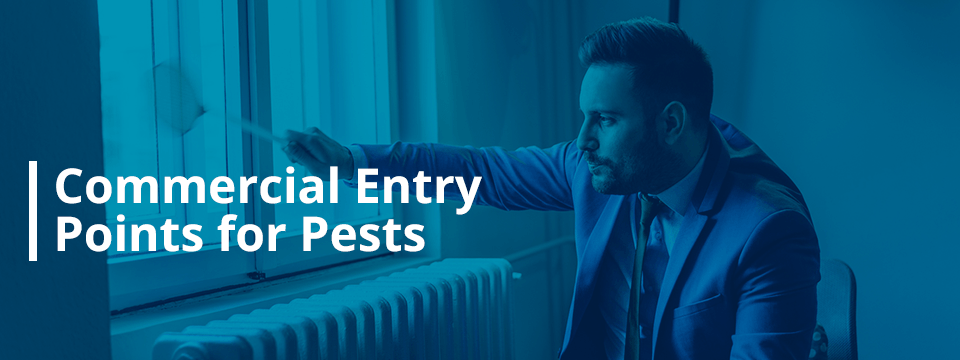
The cleanliness, appearance and safety of your business’ facilities play a significant role in what customers, especially first-time customers, think of your company. Because of this, a pest problem is of particular concern for commercial facilities.
Commercial buildings often have a lot of shared ceilings, shared walls and common areas, meaning that it’s even more important to act quickly as even a small pest problem can rapidly become larger and harder to contain. Sightings of pests in common areas, such as bathrooms, lobbies, cafeterias, break areas and foyers, can be a huge turnoff for visitors and employees. Rodents and insects can also travel into occupied spaces that contain equipment and electrical wiring, creating even more issues.
When pests enter work areas, they cause disruptions and lead to employees and patrons being uncomfortable in your facility. Pests like cockroaches and bed bugs can be brought into the workplace by employees when they crawl into personal belongings at home and back out when the employee reaches their workplace.
Many pests can cause issues in an industrial building. Rats and mice can gnaw on wiring and create fire hazards or damage equipment. Ants may be drawn to electrical equipment and cause disruptions in power if they swarm the equipment in large numbers. Cockroaches can hide and multiply very quickly. This means identifying and tackling pest problems as quickly as possible is crucial for commercial properties.
Top 5 Pest Entry Points for Businesses
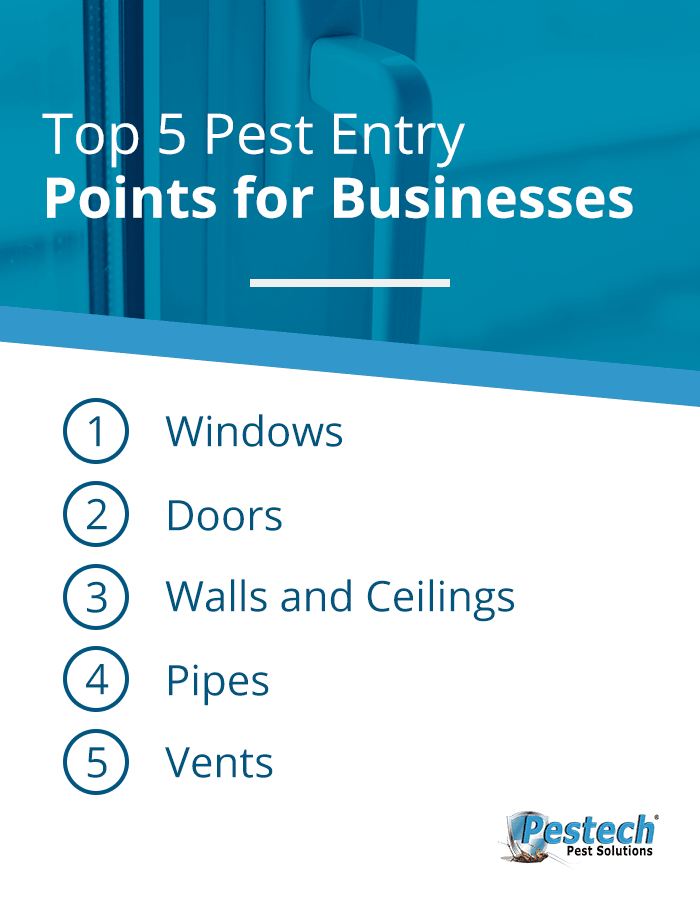
To keep pests out of your commercial building, it’s important to know the ways they typically get in. Here are a few common pest entry points for commercial properties, such as shared office buildings, standalone offices and warehouses.
- Windows
One of the most common commercial pest entry points is windows. To keep pests from entering your building via the windows, be sure that your windows include screens and that they don’t have any holes in them. If your window screens have holes, you should replace the screen, as even tiny holes provide enough room for an insect to get through. Inspecting window screens regularly will ensure that they are replaced as soon as necessary to prevent a pest infestation. Remember to always inspect windows and screens after a storm.You should also make sure that all windows close properly and that every window is shut before the building is closed for the night. Windows that are left open overnight can easily usher in pests. You’ll also want to look for cracks in the window frames and seal them. Use moisture-resistant caulk to seal gaps, which can prevent pests from getting in and offers the added bonus of making your building more energy-efficient. If these gaps are too big, you may want to replace the windows. - Doors
Another common entry point in commercial buildings for pests is doors. Doors connect your business with the outside world but may also let the outside world in. Make sure your exterior doors close properly and don’t have gaps. Examine the door frames for any cracks that require sealing. Weatherstripping may also be beneficial, as it can help prevent pests from entering your building and also defend against the elements. Loading docks are common pest entry points in warehouses and other industrial buildings, so be sure to check those too if you have them. - Walls and Ceilings
Exterior damage can usher pests into your office building. Cracks or crevices don’t need to be very big to let in plenty of pests. You’ll want to keep the exterior of your building well maintained to prevent pests from entering and to create a less hospitable environment for them. - Pipes
Many pests are drawn to water, which means your pipes may attract them. Not only can this create a pest problem, but it can also lead to plumbing problems, such as leaks. Cockroaches and ants will typically find their way to bathrooms and kitchens because they’re drawn to the moisture in these areas. You may also deal with termites that want to chew through moist wood or pests that create blockages in your pipes.
Worse, when a plumbing problem occurs, the leaks can attract rodents and insects. This creates an even bigger problem. Fix leaky pipes, broken water heaters and dripping faucets as soon as possible. If you notice an issue with your plumbing, don’t hesitate to take action because pests will only continue to make the problem worse. - Vents
Vents transfer air outside, but they can also allow in pests. Though most pests won’t live in vents, as they don’t like dry conditions or the airflow, they can still use a vent as a way to navigate from the outside world to the interior of your building. Dryer vents and kitchen vents are especially popular routes for pests who are seeking a hospitable indoor location.Pests can enter through these dryer vents into the room where the dryer is located and then continue to other areas of the building. They may also get in through kitchen vents, which poses a particularly significant health and safety concern.To prevent pests from entering through vents, obtain covers to block pests from using them as a travel route into your building. While addressing your vents, you’ll also want to check that there haven’t been any pests, particularly rodents, that may be chewing into your vents.
To keep pests out of your office buildings, restaurants, warehouses and other industrial buildings, know these common entry points and take steps to prevent pests from using them. Professionals in pest management can help with this.
Common Commercial Pests
There are numerous pests that commercial facilities need to watch out for. We have compiled a list of the most common pests to look out for in your facility.
- Rodents
Rodents, especially mice and rats, are some of the most common pests on commercial properties. Depending on your location, neighboring properties and your structural condition, your property could be especially susceptible to a rodent infestation. Being aware of the realities of your specific situation and creating a rodent management program that accounts for your property’s particular needs is essential for successfully keeping rodents out of your facility. - Flies
There are several species of flies that can quickly become nuisances in a business setting, including horse flies, bluebottle flies, cluster flies, sand flies, fruit flies, drain flies, lacewings, fermentation flies, flesh flies, bush flies and house flies.House flies enter buildings through open doors. Though breeding isn’t often a problem indoors, house flies can be an annoying distraction and a hazard to both sanitation and food safety, as they carry pathogens that can spread to food and surfaces. Other fly species are also a nuisance and can present risks to food safety. Reduce your risk of a fly problem by reviewing your plan for pest management, especially in regard to the entry points and loading docks of your facility.
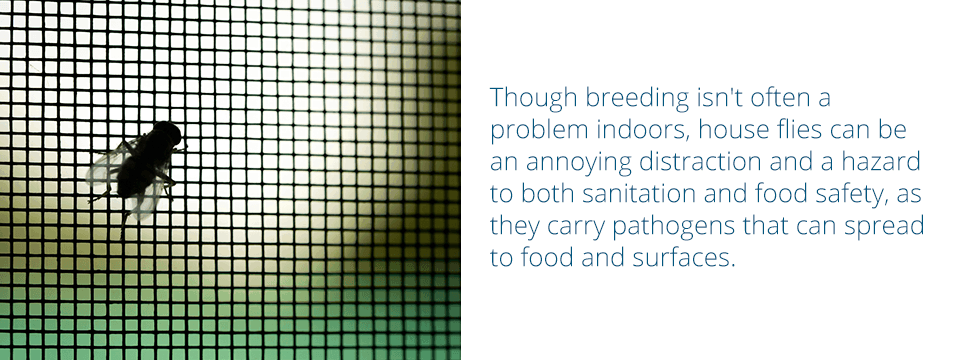
- Birds
Birds can present an issue for the roofs of commercial properties. The roof can often get overlooked when businesses are creating their plan for pest management, but birds tend to take up residence on rooftops and use them for resting and scouting for food. Their droppings can be corrosive, creating a mess and causing damage to structures.Critical equipment on the roof for the building’s HVAC system may be susceptible to damages from birds, as they produce warmth and shelter that appeals to birds. Feathers and droppings can be left behind and obstruct airflow after they enter the air system. These feathers and droppings may carry parasites and pathogens that present risks to humans. Among birds, pigeons are a particularly challenging pest. - Moths
Moths, along with other insects that fly at night, are attracted to facility lights. They can enter a building through crevices, cracks, open windows and open doors. Discuss your lighting options with a pest control professional who may be able to suggest ways to reduce the attraction of the lights to moths and other night-flying insects. - Spiders
Spiders can enter buildings through vents, crevices, cracks and pipes. They can also hide in personal items and deliveries and be unknowingly carried into buildings. Many people have a fear of spiders, which can mean that spotting a spider can create a larger issue for your employees and patrons. - Gnats
Though these pests are small, they can cause big problems. Typically, gnats become a problem when they are near plants, drains, trash cans or recycling bins or when they are in restrooms, kitchens, break rooms or janitorial closets. They tend to collect where there is built-up moisture and organic debris. Gnats can also become a nuisance around the outside of commercial properties in warmer months. When they swarm near entrances, they can annoy employees and patrons who are trying to get inside. - Ants
An ant species known as pavement ants can be a particular nuisance to a business. They get their name for their tendency to build nests under or near foundations, sidewalks and asphalt. This can result in quite a problem for many industrial buildings. Because of walkways and parking lots, ants can easily get inside a building in the pursuit of food, water and warmth. - Crickets
Though they typically don’t appear in large numbers in the interior of a commercial building, a cricket will certainly make its presence known when it manages to get inside. Crickets can be loud and disruptive but also difficult to find, which can make eliminating the disruption particularly tricky. - Ground Beetles
Beetles are pests that tend to be brought in via deliveries and shipments. They might also crawl in on their own through cracks or open doors. Inspecting the deliveries brought to your facility can help prevent these pests from getting into your building. You may want to establish a proofing or exclusion service for sealing crevices and cracks and installing door sweeps that will stop beetles and other pests from making their way under doors. - Other Invaders
Other pests, such as silverfish, stink bugs, centipedes, boxelder bugs and earwigs, may invade more occasionally rather than as a large infestation.
If you’re facing pest problems or want to prevent them before they occur, you can schedule integrated pest management that takes an effective and environmentally friendly approach to the control of pests.
Tips for Commercial Pest Prevention
Besides knowing and maintaining your entry points, we have a few more tips to help you keep pests out of your commercial facility.
- Clean Up Moisture and Wet Spots
Since many insects like cockroaches and ants are attracted to moisture, clean up wet spots from leaks or spills as soon as possible. Wet areas can also cause wood to soften, which makes it easier for ants and other pests to build nests in it. There’s also the added danger of the walls becoming damaged, so be sure to address any areas with moisture as quickly as you can.
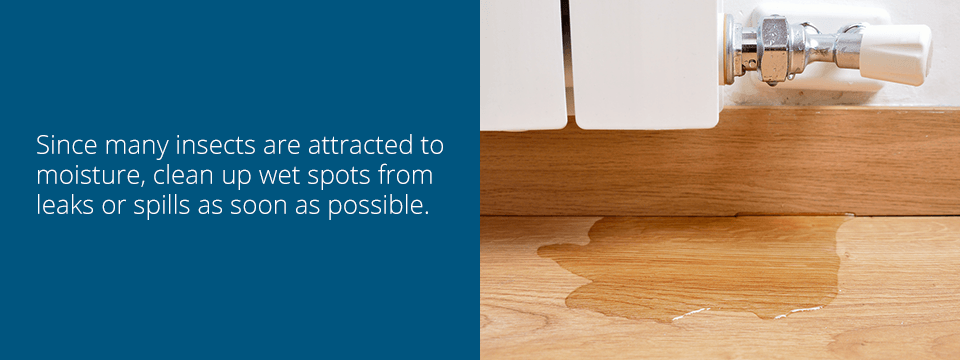
- Establish a Food and Drink Policy
Staff members should be encouraged to consume food and beverages in a break room rather than at their desks. They should also cover uneaten food and keep drinks in mugs with lids or in bottles. Food should also never be left outside a cabinet or refrigerator overnight. - Inspect Containers
Pests can sneak into an office building on bags and in containers, so inspect these items before they enter the facility. Also, dispose of packaging quickly. - Empty the Trash Often
Trash attracts pests because it can be a food source for them. Once they know there is a food source, they will keep returning, creating a bigger and bigger problem. By ensuring that trash receptacles are emptied regularly rather than being left full overnight, you can prevent a possible infestation in your building. Empty trash into outdoor bins and seal them tightly to prevent pests from entering them and lingering near your property. - Get Rid of Clutter
Clutter can create an ideal space for pests to hide, so declutter often and avoid leaving messes around the workplace. When messes do occur, they should be cleaned promptly and thoroughly. - Schedule Inspections and Preventative Services
One of the best ways for you to keep pests away from your commercial property is by scheduling regular inspections and preventative services for pest management in which professionals look for signs of potential issues and treat any possible problem areas.
Commercial Pest Prevention and Control Services From Pestech Pest Solutions
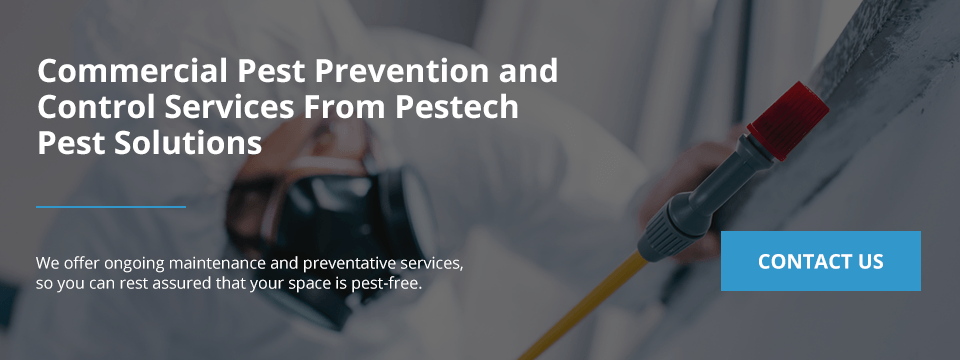
At Pestech Pest Solutions, we offer integrated pest management solutions for businesses in New York. Our 100% satisfaction guarantee ensures that every pest problem is solved, even the most difficult. If we aren’t successful during our first service, we will return at no additional cost until the pest problem is gone. We offer ongoing maintenance and preventative services, so you can rest assured that your space is pest-free.
Call us to schedule an inspection or contact us online to learn more about our pest management services.
Contact Us About a Pest Problem
Call Us to Schedule an Inspection
